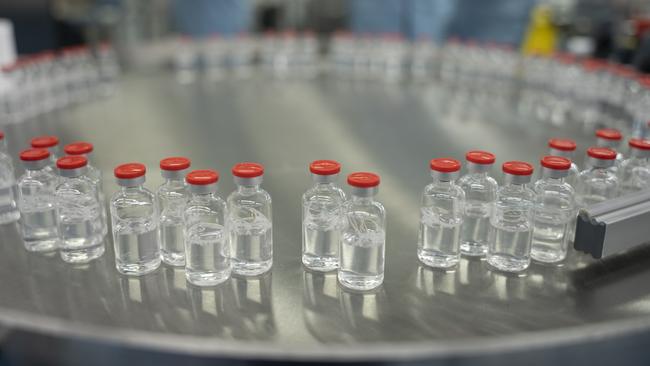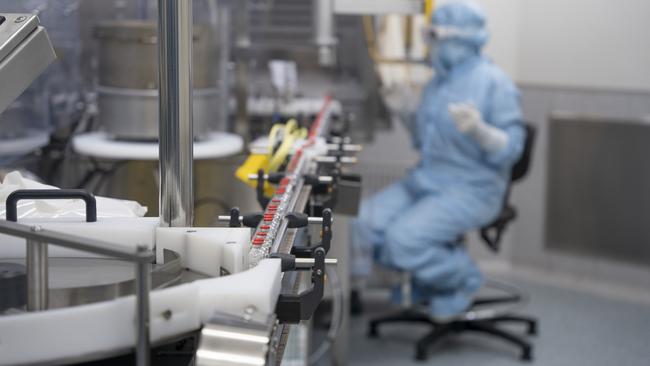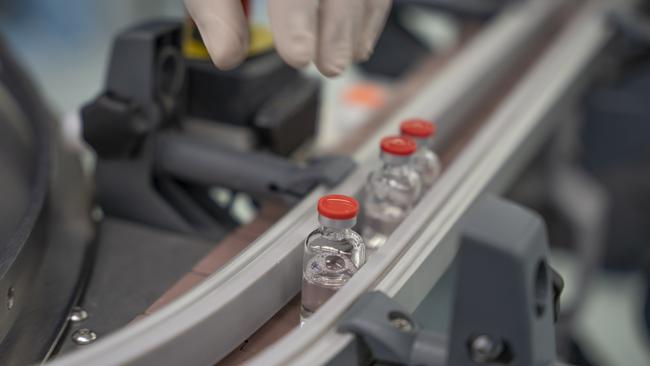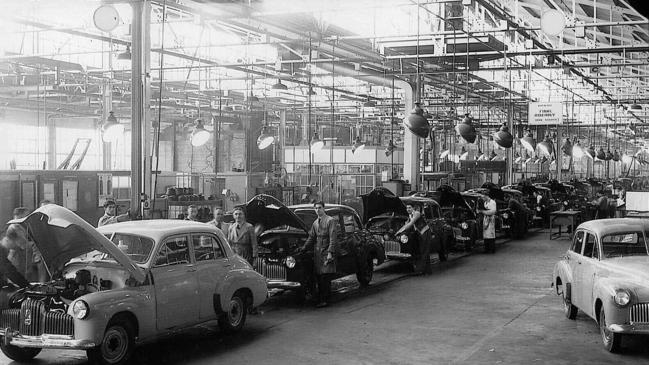Industry strategy at pointy end of building our future
This pandemic has shown us how vulnerable supply chains can be, but reports of the rebirth of Australian manufacturing are misleading.

In coming days, filled and finished vials of the locally made AstraZeneca COVID-19 vaccine will be trucked out from a Seqirus plant in Melbourne’s Parkville, distributed around the country, and then be injected into the arms of those in our top-priority groups.
Perhaps only 15 nations have the capability to manufacture vaccines of this kind, a point of pride as well as a deep source of peace of mind, amid the global jostling for inoculations and supplies. Taxpayers provided the funds to retool two CSL facilities and, of course, every other part of the federal vaccine program costing $6.3bn and rising.
CSL has a contract with AstraZeneca to supply 50 million doses of the adenovirus-based vaccine. An ace in the hole, for sure, but one that is something of a lucky draw given the mutations of Australia’s industry structure and economic policies.
CSL is now a $116bn global biotherapeutics company, domiciled here, born out of the government-owned Commonwealth Serum Laboratory established in 1916 to make vaccines, serums and antitoxins for a country isolated in war.
CSL’s chief scientific officer, Andrew Nash, talks about developing a strong ecosystem of advanced manufacturing. We have no trouble getting great ideas that come out of front-end research, which Australia does well because of government and university support, but progressing through the other stages, or “value inflection points” in the jargon, to get traction and commercialise that research is where more assistance is required.
“For companies like CSL to be successful we need a strong manufacturing sector here,” Nash tells Inquirer. “Vibrant start-ups and mid-sized companies in medical products doing the manufacturing, research and training skilled workers ultimately benefits us as well. Support has to be there for companies at those critical middle stages.”
CSL will soon be breaking ground at a new $800m cell-based vaccine manufacturing facility in Tullamarine, adjacent to Melbourne Airport. It will be finished in 2026 and will produce influenza and other vaccines. The project is supported by a $1bn purchase agreement for vaccines over 10 years with the Australian government.

The coronavirus pandemic has shown us how vulnerable supply chains can be and has changed the conversation around sovereign manufacturing capability and building resilience to shocks. Industry policy is again in vogue, especially in the niche worlds of business lobbying, policy development and scientific research.
Yet reports of the rebirth of Australian manufacturing are as misleading as the customary epitaphs that accompany plant closures and the offshoring of jobs. For Louise McGrath, head of industry development and policy at national employer association Ai Group, claims of being on the cusp of a new era in manufacturing seem like “a big call”.
“We are in a new era of supporting Australian manufacturing with clearer direction for industry in what sectors will be supported and what activities will be encouraged,” McGrath says. “Also, there appears to be a stronger focus on encouraging companies to look up and out of their existing sectors and understand what transferable technology and know-how can be utilised to exploit opportunities in other sectors.”
Manufacturing remains an important part of the economy, but it is not your nanna or pop’s world of mass production, high-wage male employment for life, and second-division-quality goods. In fact, it’s none of those things, and all the better for it.
Manufacturing accounts for 6 per cent of gross domestic product and employs 848,000 workers, or 6.6 per cent of the workforce. Jobs in this sphere are often in services that support production, such as research, design, marketing, distribution and after-sales service. The long-run decline in manufacturing has occurred in virtually every rich country, says Productivity Commission chairman Michael Brennan, who warns against repeating past mistakes of picking winners on taxpayers’ funds.
“Australia shouldn’t be too hard on itself,” Brennan says of our current industry structure. “The economic policy framework of the last 30 years has given us one of the highest incomes in the world and provided a foundation for Australia to weather the last two global economic shocks better than most of the developed world.
“Being an open economy with flexible settings and low public debt has been a source of advantage and being a resource exporter hasn’t hurt either. Australia has a slightly different economic structure to most other advanced economies – what works for them may not be right for us.”
Still, a great deal of national prowess is captured in this idea of being a manufacturing country, especially among Boomers and politicians on the make. “We make things in Australia. We do it well,” Scott Morrison said in October, launching a $1.5bn national strategy in six priority areas.
“The reality is we cannot and should not seek to reach global scale in a large number of sectors. Don’t try to do everything. It’s all about alignment, across different levels of government, with industry and with the research and education sectors.”

The so-called Modern Manufacturing Strategy comes out of the Prime Minister’s hand-picked National COVID-19 Commission (Advisory Board), headed by businessman Nev Power, and its industry taskforce offshoot, run by former Dow Chemicals chief Andrew Liveris.
The strategy’s priorities are resources technology, food and beverages, medical products, recycling and clean energy, defence, and space. It will see Canberra become a strategic investor to help manufacturers scale up, become more competitive and build more resilient supply chains.
The buckets of money include grants from a Manufacturing Modernisation Fund; a Supply Chain Resilience Initiative; and a $1.3bn pot known as the Modern Manufacturing Initiative, offering grants for major projects worth at least $2m. The co-funding grants range from $1m to $20m, for businesses that integrate operations into local and global value chains.
Over the past few months funding rounds have opened for three streams, which have been designed by industry leaders. But the signature grants program is experiencing teething problems, according to Ai Group’s McGrath.
“Feedback from companies is that the application process seems both rushed and slow,” she says of the short application deadline when a round opens and the long wait for a decision. “The current program assumes there are $2m projects ready and waiting. This means any opportunity for blue-sky strategic thinking is lost.”
To say industry policy is a hodgepodge is an understatement, with all manner of slogans, incentives and bureaucracies. Companies are finding it difficult to find their way through it, particularly small and medium enterprises that would benefit most; typically, smaller companies invest more than large companies, but have nowhere near the rates of return on capital outlays.

The Morrison government maintains it is using existing support schemes and mechanisms, while trying to craft an overarching narrative for a post-pandemic rebound and job creation. Former Productivity Commission chairman Gary Banks is not convinced.
“There has been no transparency and not even a coherent economic rationale,” Banks writes in an email. “This is not only problematic for this initiative. It will encourage more rentseeking and further poor policy down the track. Some have been drawing parallels with the Fraser years. I must admit that all the ‘pragmatism’ talk does have a sense of deja vu.”
Not surprisingly, Labor, too, wants to occupy this policy ground. “It’s great to be here to talk about rebuilding a manufacturing sector in this country,” Anthony Albanese told EDI Downer’s train builders in Maryborough, Queensland, last month, echoing the theme of his budget reply speech last year.
“We’ve lost too many manufacturing jobs. And one of the things that has shown out during the pandemic is the fact that we’re not self-reliant, we can’t look after ourselves when things go wrong.”
In its draft national platform, which will be debated at the end of the month in a special conference, Labor sets out an even more activist industry policy than the Coalition, with specific sectoral plans in a dozen areas, including energy and renewables, chemicals and fertilisers, and building materials.
People in the political and industrial wings of the labour movement are attracted to ideas espoused by Mariana Mazzucato. In books such as The Entrepreneurial State and The Value of Everything, the Italian-American economist, based at University College London, has detailed an expanded role for government, especially in innovation.
“To solve the massive crises facing us, we must be innovative — we must use collaborative, mission-oriented thinking while also bringing a stakeholder view of public private partnerships, which means not only taking risks together but also sharing the rewards,” she writes in Mission Economy, her latest book. “We need to think bigger and mobilise our resources in a way that is as bold, as inspirational as the moon landing — this time to the most ‘wicked’ social problems of our time.”
The Business Council of Australia, the voice of the nation’s largest employers, offers strong endorsement of the Morrison government’s new industry strategy. In its pre-budget submission, published this week, the BCA argues for a suite of tax breaks and assistance to turn our world-class ideas and research into jobs by setting national priorities and focusing on our existing and emerging strengths.
The BCA says assistance should be scaled for impact and not be spread too thinly, while the new scheme should support partnerships between universities and business, and back in the modern manufacturing strategy, with government willing to co-invest with the private sector and universities to grow new industries, which will grow new jobs.
Whatever shape this manufacturing push takes, however, it’s unlikely to lead to the plump employment shares of the past, no matter how emphatic the “jobs, jobs, jobs” mantra from national leaders. The demand for workers is likely to be for the most skilled, the top three of five occupational classifications.
This week in her first address to the National Press Club, our new Chief Scientist, Cathy Foley, said her focus was to “take our science to impact”.
“There is no shortage of excellent research in Australia,” she said. “Our discovery research must continue. But let’s be frank, our research is not being translated into new products and innovations nearly as often as it could be. As a result, Australian ideas and industries are being lost offshore.”
Foley’s previous role at the CSIRO was linking the work of researchers, start-ups and industry. She believes we have all the components for success: quality research, industrial capability, and institutional and regulatory strength. As well, there’s no shortage of effort or investment, expertise, or peak organisations.
“What we need to do is pass the baton more efficiently,” she said, using the analogy of an Olympic track relay team. “We need to make sure the system links up at these interfaces. Science is where we start. But science cannot do it alone.
“We need to engineer the solutions, with the right design and user interface. We need the right business model, supporting policy and regulation, and the social licence to ensure that a given technology is what society is willing to support.”
A coalition of medical manufacturing exporters, including CSL, Cochlear and ResMed, is also pushing for a new regime around the tax treatment of intellectual property and a globally competitive company tax rate, to bring us closer to R & D and commercialisation regimes in the US, Britain, France, Switzerland and Singapore.
Cutting corporate tax has been a bridge too far, especially for Coalition governments facing hostile Senates. A debt heading toward $1 trillion amid still chunky federal budget deficits, means the ask is ambitious. But the medical exporters believe a “patent box” scheme, of a 10 per cent effective corporate tax rate on eligible IP would be a game-changer.
A research paper in August by the Queensland Productivity Commission on building economic resilience in the state in the wake of the pandemic highlighted the folly of previous assistance schemes, including for cars, fruit juice, magnesium and home insulation. Poorly targeted subsidies prop up failing firms, hinder entrepreneurship, stall job creation and hamper business dynamism.
To avoid creating industry policy that inadvertently harms other industries or firms, results in higher prices for consumers, stifles competition and productivity or fails to achieve its objective, the QPC suggested policy should focus on framework conditions that allow firms to adapt and innovate. To minimise risks, a form of “soft” industry policy would see “a facilitative, co-ordinating role for government”.
Perhaps that’s where we are heading, given that the amounts of money going into manufacturing programs are small by the standards of the profligate past. What would best-practice industry policy look like?
“It should be readying industry for the future, understanding what our comparative advantages are and what are the barriers that limit industry to scale up,” says Ai Group’s McGrath. “It needs more than funding programs. It needs to include a comprehensive strategy of skill development, international trade programs, regulatory reform and R & D linkages.”
PC chair Brennan argues industry policy “can play a positive role, particularly if we’re talking about the general enablers of growth and flexibility, in industrial relations, taxation, skills, innovation, infrastructure, trade policy and creating linkages between market participants”.
Brennan says the evidence of the past 30 years, however, points to the difficulty of picking winners. “The arguments usually involve getting into the manufacture of a hi-tech product, like the debate over computer chips in the early 2000s,” he says.
“One thing these proposals have in common is they tend to pick products whose world price is falling rapidly or is about to. That’s the nature of cutting-edge innovative sectors.
“What you are betting on is that you can increase productivity faster than the world price can fall – effectively a belief that your productivity will be faster than your most advanced competitor. That’s a tough threshold test.”


To join the conversation, please log in. Don't have an account? Register
Join the conversation, you are commenting as Logout